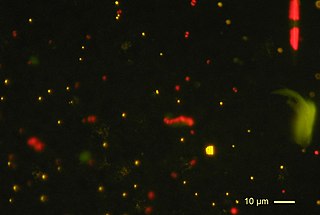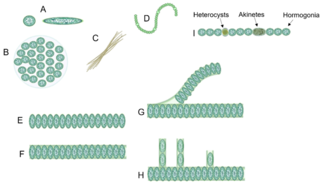
Cyanobacteria, also called Cyanobacteriota or Cyanophyta, are a phylum of autotrophic gram-negative bacteria that can obtain biological energy via photosynthesis. The name 'cyanobacteria' refers to their color, which similarly forms the basis of cyanobacteria's common name, blue-green algae, although they are not scientifically classified as algae. They appear to have originated in a freshwater or terrestrial environment.

Hormogonia are motile filaments of cells formed by some cyanobacteria in the order Nostocales and Stigonematales. They are formed during vegetative reproduction in unicellular, filamentous cyanobacteria, and some may contain heterocysts and akinetes.

Heterocysts or heterocytes are specialized nitrogen-fixing cells formed during nitrogen starvation by some filamentous cyanobacteria, such as Nostoc, Cylindrospermum, and Anabaena. They fix nitrogen from dinitrogen (N2) in the air using the enzyme nitrogenase, in order to provide the cells in the filament with nitrogen for biosynthesis.

Nostoc, also known as star jelly, troll's butter, spit of moon, fallen star, witch's butter, and witch's jelly, is the most common genus of cyanobacteria found in a variety of both aquatic and terrestrial environments that may form colonies composed of filaments of moniliform cells in a gelatinous sheath of polysaccharides. It may also grow symbiotically within the tissues of plants, providing nitrogen to its host through the action of terminally differentiated cells known as heterocysts. Nostoc is a genus that includes many species that are diverse in morphology, habitat distribution, and ecological function. Nostoc can be found in soil, on moist rocks, at the bottom of lakes and springs, and rarely in marine habitats. It may also be found in terrestrial temperate, desert, tropical, or polar environments.
Bacillus safensis is a Gram-positive, spore-forming, and rod bacterium, originally isolated from a spacecraft in Florida and California. B. safensis could have possibly been transported to the planet Mars on spacecraft Opportunity and Spirit in 2004. There are several known strains of this bacterium, all of which belong to the Bacillota phylum of Bacteria. This bacterium also belongs to the large, pervasive genus Bacillus. B. safensis is an aerobic chemoheterotroph and is highly resistant to salt and UV radiation. B. safensis affects plant growth, since it is a powerful plant hormone producer, and it also acts as a plant growth-promoting rhizobacteria, enhancing plant growth after root colonization. Strain B. safensis JPL-MERTA-8-2 is the only bacterial strain shown to grow noticeably faster in micro-gravity environments than on the Earth surface.

Photosynthetic picoplankton or picophytoplankton is the fraction of the photosynthetic phytoplankton of cell sizes between 0.2 and 2 µm. It is especially important in the central oligotrophic regions of the world oceans that have very low concentration of nutrients.
Hydrogenobacter thermophilus is an extremely thermophilic, straight rod (bacillus) bacterium. TK-6 is the type strain for this species. It is a Gram negative, non-motile, obligate chemolithoautotroph. It belongs to one of the earliest branching order of Bacteria. H. thermophilus TK-6 lives in soil that contains hot water. It was one of the first hydrogen oxidizing bacteria described leading to the discovery, and subsequent examination of many unique proteins involved in its metabolism. Its discovery contradicted the idea that no obligate hydrogen oxidizing bacteria existed, leading to a new understanding of this physiological group. Additionally, H. thermophilus contains a fatty acid composition that had not been observed before.

Nostoc punctiforme is a species of filamentous cyanobacterium. Under non-limiting nutritional environmental conditions, its filaments are composed of photosynthetic vegetative cells; upon nutrient limitation, some of these cells undergo differentiation into heterocysts, akinetes or hormogonia.

Nostoc commune is a species of cyanobacterium in the family Nostocaceae. Common names include star jelly, witch's butter, mare's eggs, fah-tsai and facai. It is the type species of the genus Nostoc and is cosmopolitan in distribution.
Armatimonas rosea is a Gram-negative bacterium and also the first species to be characterized within the phylum Armatimonadota. The Armatimonadota were previously known as candidate phylum OP10. OP10 was composed solely of environmental 16S rRNA gene clone sequences prior to A. rosea's discovery.
Fimbriimonas ginsengisoli is a Gram-negative bacterium and the first representative of the class Fimbriimonadia within the phylum Armatimonadota. The Armatimonadota were previously known as candidate phylum OP10. OP10 was composed solely of environmental 16S rRNA gene clone sequences prior to F. ginsengisoli's relative, Armatimonas rosea's discovery.

Oscillatoria princeps is the type species (lectotype) of the cyanobacterial genus Oscillatoria.
Xenophilus azovorans is a bacterium from the genus Xenophilus which has been isolated from soil in Switzerland.
Trichodesmium thiebautii is a cyanobacteria that is often found in open oceans of tropical and subtropical regions and is known to be a contributor to large oceanic surface blooms. This microbial species is a diazotroph, meaning it fixes nitrogen gas (N2), but it does so without the use of heterocysts. T. thiebautii is able to simultaneously perform oxygenic photosynthesis. T. thiebautii was discovered in 1892 by M.A. Gomont. T. thiebautii are important for nutrient cycling in marine habitats because of their ability to fix N2, a limiting nutrient in ocean ecosystems.
Microbial DNA barcoding is the use of DNA metabarcoding to characterize a mixture of microorganisms. DNA metabarcoding is a method of DNA barcoding that uses universal genetic markers to identify DNA of a mixture of organisms.
Halorhodospira neutriphila is a bacterium from the genus of Halorhodospira which has been isolated from a microbial mat from a marine saltern from Rhone Delta in France. The microbial mat forms at the sediment surface and is between 10 and 20 mm thick, below a fine layer (2–3 cm) of gypsum crust. The mat is composed of a red layer of purple bacteria strains below a green layer of cyanobacteria, interspersed with sulfur globules, and occasionally covered by halite deposits. These mat forming microbes live in anoxic muds and sediments and form a benthic mat in a hypersaline lagoon environment where the salinity of the water ranges from 240-320‰ of total salinity. H. neutriphila was isolated from the red layer of the microbial layer and found to be extremely halophilic and well adapted to withstand the extreme saline conditions of their modified marine habitat. The type strain was identified as strain SG 3301T.
Thiosocius is a genus of bacteria that lives in symbiosis with the giant shipworm Kuphus polythalamius. It contains a single species, Thiosocius teredinicola, which was isolated from the gills of the shipworm. The specific name derives from the Latin terms teredo (shipworm) and incola (dweller).
Sphingobacterium olei is a Gram-stain-negative, rod-shaped, and non-motile bacterium. It was first isolated from oil-contaminated soil in Daqing oil field, China. S. olei has been found to be able to degrade herbicides quizalofop-p-ethyl and diclofop-methyl. Before a name was given, S. olei was designated as strain HAL-9T. The species name olei means "of oil" in Latin.

Cyanobacterial morphology refers to the form or shape of cyanobacteria. Cyanobacteria are a large and diverse phylum of bacteria defined by their unique combination of pigments and their ability to perform oxygenic photosynthesis.
Actinomyces massiliensis is an anaerobic, mesophilic, Gram-positive bacterium originally isolated from a human blood sample and belonging to the genus Actinomyces.








